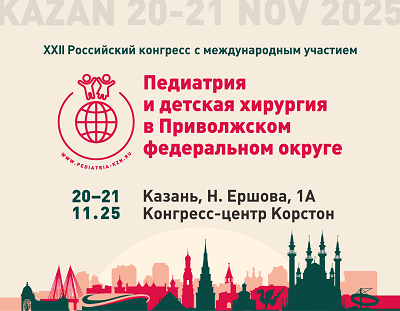Rare variant of heterotaxy syndrome in childhood in pulmonology clinic
https://doi.org/10.21508/1027-4065-2022-67-6-88-92
Abstract
Heterotaxy syndrome is a congenital malformation in which the internal organs of the chest and abdominal cavity have an abnormal location. People suffering from this syndrome have multiple complex defects in the heart, blood vessels, spleen, liver, lungs and other organs. Heterotaxy is a rare pathology that requires a multidisciplinary approach to diagnosis. This article demonstrates a rare case of heterotaxy observed in the pulmonology clinic of the Veltischev Institute.
About the Authors
Yu. L. MizernitskiyRussian Federation
Moscow
A. A. Novak
Russian Federation
Moscow
I. E. Zorina
Russian Federation
Moscow
S. E. Ryabova
Russian Federation
Moscow
I. A. Kovalev
Russian Federation
Moscow
E. G. Verchenko
Russian Federation
Moscow
V. S. Bereznitskiy
Russian Federation
Moscow
L. P. Melikyan
Russian Federation
Moscow
L. V. Egorov
Russian Federation
Moscow
References
1. Jacobs J.P., Anderson R.H., Weinberg P.M., Walters H.L., Tchervenkov C.I., Duca D.D. et al. The nomenclature, definition, and classification of cardiac structures in the setting of heterotaxy. Cardiol Young 2007; 17: 1–28. DOI: 10.1017/S1047951107001138
2. Shiraishi I., Ichikawa H. Human heterotaxy syndrome–from molecular genetics to clinical features, management and prognosis. Circ J 2012; 76: 2066–2075. DOI: 10.1253/circj.cj-12–0957
3. Zhu L., Belmont J., Ware S. Genetics of human hetero-taxias. Eur J Hum Genet 2006; 14: 17–25. DOI: 10.1038/sj.ejhg.5201506
4. Novak A.A., Mizernitskiy Yu.L. Primary ciliary dyskinesia: state of the problem and prospects. Meditsinskiy sovet 2021; 1: 276–285. (in Russ.) DOI: 10.21518/2079–701X-2021–1–276–28
5. Purandare S.M., Ware S.M., Kwan K.M., Gebbia M., Bassi M.T., Deng J.M. et al. A complex syndrome of left–right axis, central nervous system and axial skeleton defects in Zic3 mutant mice. Development 2002; 129: 2293–2302. DOI: 10.1242/dev.129.9.2293
6. Yan Y.L., Tan K.B., Yeo G.S. Right atrial isomerism: preponderance in Asian fetuses. Using the stomach-distance ratio as a possible diagnostic tool for prediction of right atrial isomerism. Ann Acad Med Singap 2008; 37: 906–912
7. Ortega-Zhindón D.B., Flores-Sarria I.P., Minakata-Quiróga M.A., Angulo-Cruzado S.T., Romero-Montalvo L.A., Cervantes-Salazar J.L. Atrial isomerism: A multidisciplinary perspective [Isomorfismo cardiaco: Una perspectiva multidisciplinaria]. Arch Cardiol Mex 2021;91(4):470–479. DOI: 10.24875/ACM.20000567
8. Van Praagh S. Cardiac malpositions and the heterotaxy syndrome. In Nadas’s Pediatric Cardiology. Second edition. Ed. J.F. Keany, J.E. Lock, D.C. Fyler. Philadelphia: Saunders Elsevier, 2006; 589–608
9. Kim S.J. Heterotaxy syndrome. Korean Circ J 2011; 41: 227–232
10. Kothari S.S. Non-cardiac issues in patients with heterotaxy syndrome. Ann Pediatr Cardiol 2014; 7: 187–192. DOI: 10.4103/0974–2069.140834
11. Anderson R.H., Brown N.A., Meno C., Spicer D.E. The importance of being isomeric. Clin Anat 2015; 28: 477–486. DOI: 10.1002/ca.22517
12. Loomba R., Shah P.H., Anderson R., Arora Y. Radiologic considerations in Heterotaxy: need for detailed anatomic evaluation. Cureus 2016; 8(1): e470. DOI: 10.7759/cureus.470
13. Ho S.Y., Seo J.W., Brown N.A., Cook A.C., Fagg N.L., Anderson R.H. Morphology of the sinus node in human and mouse hearts with isomerism of the atrial appendages. Br Heart J 1995; 74: 437–442. DOI: 10.1136/hrt.74.4.437
14. Renier H. Intra-Abdominal Abnormalities Associated with Polysplenia Syndrome. J Belg Soc Radiol 2019; 103(1):54. DOI: 10.5334/jbsr.1903
15. Marx G.R. Echocardiography in heterotaxy syndrome. World J Pediatr Congenit Heart Surg 2011; 2: 253–257. DOI: 10.1177/2150135110397671
16. Loomba R., Shah P.H., Anderson R.H. Fetal Magnetic Resonance Imaging of Malformations Associated with Heterotaxy. Cureus 2015; 7(5): e269. DOI: 10.7759/cureus.269
17. Kulkarni A., Patel N., Singh T.P., Mossialos E., Mehra M.R. Risk factors for death or heart transplantation in single-ventricle physiology (tricuspid atresia, pulmonary atresia and heterotaxy): a systematic review and meta-analysis. J Heart Lung Transplant 2019; 38: 739–747. DOI: 10.1016/j.healun.2019.04.001
18. Ma L., Selamet Tierney E.S., Lee T., Lanzano P., Chung W.K. Mutations in ZIC3 and ACVR2B are a common cause of heterotaxy and associated cardiovascular anomalies. Cardiol Young 2012; 22(2): 194–201. DOI: 10.1017/S1047951111001181
Review
For citations:
Mizernitskiy Yu.L., Novak A.A., Zorina I.E., Ryabova S.E., Kovalev I.A., Verchenko E.G., Bereznitskiy V.S., Melikyan L.P., Egorov L.V. Rare variant of heterotaxy syndrome in childhood in pulmonology clinic. Rossiyskiy Vestnik Perinatologii i Pediatrii (Russian Bulletin of Perinatology and Pediatrics). 2022;67(6):88-92. (In Russ.) https://doi.org/10.21508/1027-4065-2022-67-6-88-92











































